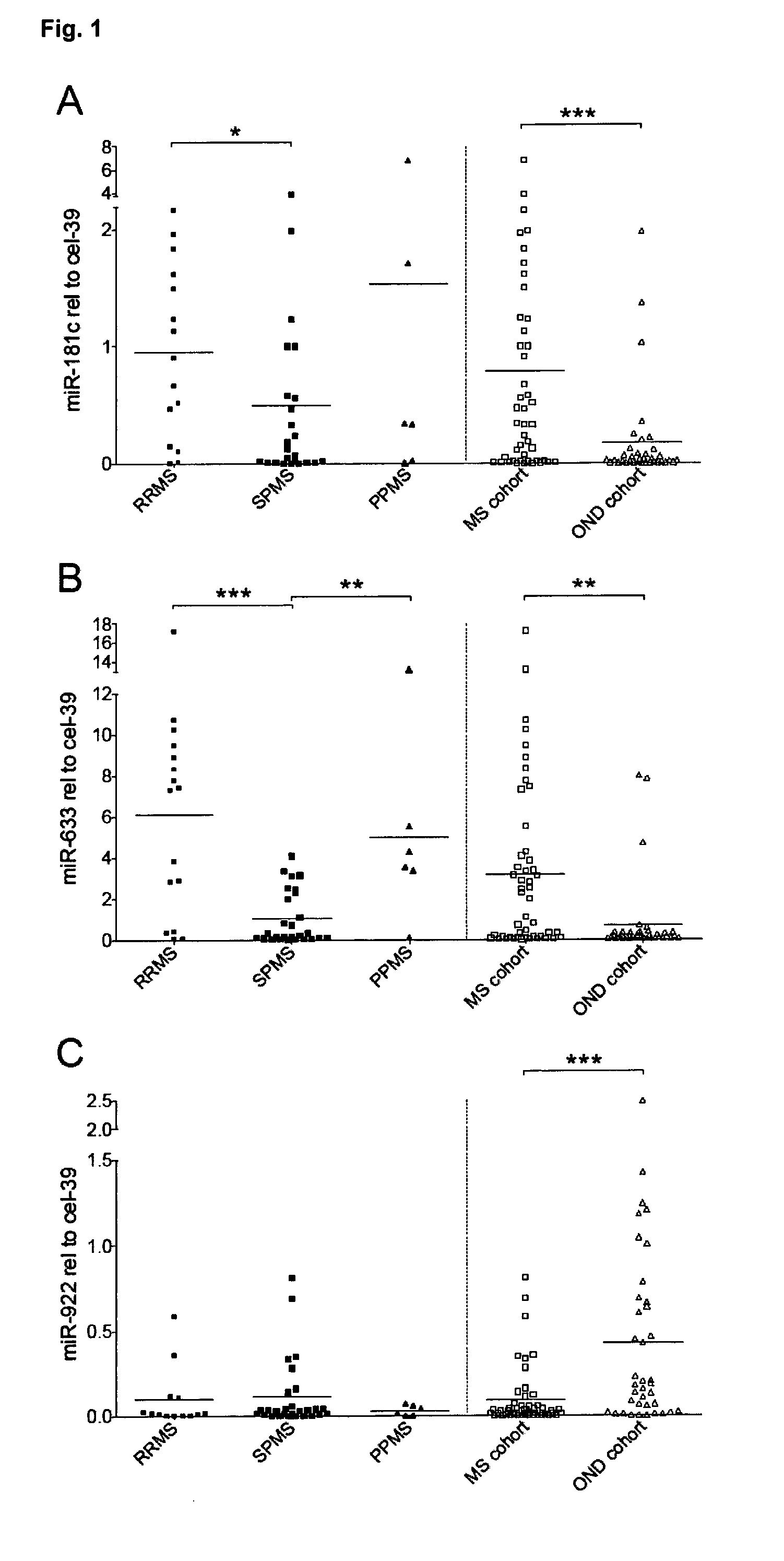Microrna profiles in the diagnosis of multiple sclerosis
a technology of microrna profiles and multiple sclerosis, applied in combinational chemistry, chemical libraries, libraries, etc., can solve the problems of irreversible disease progression and disability, damage or destruction of myelin surrounding nerve cells, and affecting ability,
- Summary
- Abstract
- Description
- Claims
- Application Information
AI Technical Summary
Benefits of technology
Problems solved by technology
Method used
Image
Examples
example 1
miRNAs in the CSF of MS and OND Patients
[0054]The candidate miRNAs identified by miRnome analyses were validated by quantitative miRNA RT-PCR, which revealed the following results: in MS CSF miR-922 (p=0.0001) was downregulated, whereas miR-181c (p=0.0007) and miR-633 (p=0.0014) were upregulated as compared to OND (FIG. 1A-C). None of the three candidate miRNAs correlated with age or gender. Further analyses of miRNA levels in MS patients with either relapsing remitting (RRMS, n=17) or secondary progressive (SPMS, n=30) showed significantly downregulated levels of miR-633 (p=0.0005) and miR-181c (p=0.02) in RRMS as compared to SPMS (FIG. 1A-C). The candidate miRNAs did not correlate with MS disease duration.
example 2
Diagnostic Value of Candidate miRNAs
[0055]In order to evaluate the diagnostic value of the candidate miRNAs we determined miRNA specific cut-off levels deduced from receiver operating characteristics curves. Combining candidate miRNAs in a diagnostic tree, as shown in FIGS. 2A and B, resulted in enhanced specificity and sensitivity values. The combination of a cut-off value 0.47 for miR-181c (RR, 2.0; 95% CI, 1.1 to 3.7; p=0.011) led to 69% sensitivity and 82% specificity for the discrimination between RRMS and SPMS (FIG. 2A). Accordingly, the combination of a cut-off value >0.73 for miR-633 (RR, 6.1; 95% CI 2.0 to 18.2; p<0.0001) and <0.04 for miR-922 (RR, 2.2; 95% CI, 1.4 to 3.4; p<0.0001) led to 88% sensitivity and 69% specificity for the differentiation between MS and OND (FIG. 2B).
[0056]The examples demonstrate that in the CSF of MS patients three distinct miRNAs are deregulated, namely miR-181c, miR-633 and miR-922 (FIG. 1). The MS patients included in the study had been well ...
PUM
| Property | Measurement | Unit |
|---|---|---|
| concentration | aaaaa | aaaaa |
| damaged areas | aaaaa | aaaaa |
| stability | aaaaa | aaaaa |
Abstract
Description
Claims
Application Information
 Login to View More
Login to View More - R&D
- Intellectual Property
- Life Sciences
- Materials
- Tech Scout
- Unparalleled Data Quality
- Higher Quality Content
- 60% Fewer Hallucinations
Browse by: Latest US Patents, China's latest patents, Technical Efficacy Thesaurus, Application Domain, Technology Topic, Popular Technical Reports.
© 2025 PatSnap. All rights reserved.Legal|Privacy policy|Modern Slavery Act Transparency Statement|Sitemap|About US| Contact US: help@patsnap.com


